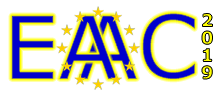Speaker
Description
The bandwidth of Thomson sources are determined, amongst others, by the bandwidth- and the length of the laser pulse and the energy spread of the electrons. Here we show that if the electron bunch's energy spread is correlated, that the emitted radiation's bandwidth can be decreased by chirping the laser pulse. The instantaneous laser frequency is given by
\begin{equation}
\frac{\partial \eta}{\partial \zeta} = \left( \frac{\langle \gamma \rangle}{\gamma(X)} \right)^2 (1 + \vec{a} \cdot \vec{a}) \frac{\omega_{l,0}}{c},
\end{equation}
where $\omega_{l,0}$ is the central laser frequency, $c$ is the speed of light, $\zeta = \frac{\omega_{l,0}}{c} (ct - z)$ is the plane wave laser phase, $X$ is the variable along which the energy spread is correlated, $\gamma$ is the Lorentz factor and $\vec{a}$ is the normalized vector potential containing the field of the laser pulse. We have solved how to construct the interaction when the energy spread is in the transverse- $\gamma = \gamma(x)$ and in the longitudinal direction $\gamma = \gamma(z)$. For each geometry the spectrum of a monochromatic electron bunch can be retrieved.

